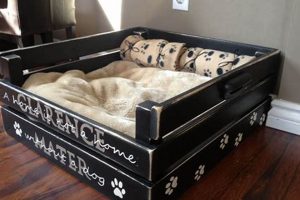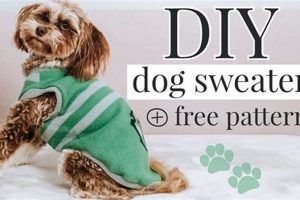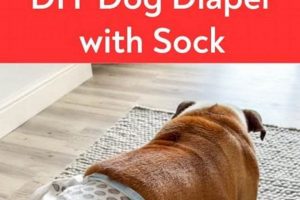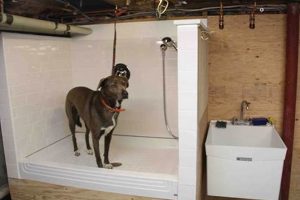The creation of customized apparel for canines involves crafting outfits from readily available materials and personal designs. An example includes transforming an old t-shirt into a superhero cape or utilizing felt to construct animal-themed attire for pets. These personalized creations allow owners to express their creativity and their pets’ personalities.
Such personalized pet attire fosters a stronger bond between owner and animal, providing an engaging activity for both. Historically, dressing animals for amusement or practical purposes dates back centuries; however, the modern focus emphasizes personal expression and participation in events such as costume contests and holiday celebrations. The practice offers an affordable and personalized alternative to commercially produced options.
The following sections will delve into specific design ideas, material selection guidelines, and safety considerations essential for successful construction of personalized canine apparel.
Construction Guidelines for Canine Apparel
The subsequent guidelines outline essential considerations for creating safe and visually appealing attire for dogs.
Tip 1: Measure Accurately: Obtain precise measurements of the dog’s neck, chest, and back length. These measurements are crucial for ensuring a comfortable and secure fit, preventing restriction of movement or potential chafing.
Tip 2: Prioritize Comfortable Materials: Opt for soft, breathable fabrics like cotton or fleece to minimize irritation. Avoid materials that may cause allergic reactions or overheating, especially for breeds prone to skin sensitivities.
Tip 3: Secure Fastenings: Utilize secure and adjustable closures such as Velcro or snaps, ensuring they are positioned away from areas easily reached by the dog’s mouth. Regularly inspect fastenings for damage or loosening to prevent accidental ingestion.
Tip 4: Avoid Small Embellishments: Refrain from using small buttons, beads, or other embellishments that could be easily chewed off and swallowed, posing a choking hazard. If decorations are necessary, securely attach them with durable stitching.
Tip 5: Consider Visibility: Incorporate reflective tape or bright colors, particularly for attire intended for nighttime use. Enhanced visibility improves safety during walks or outdoor activities in low-light conditions.
Tip 6: Keep it Simple: Elaborate designs can be tempting, but prioritize simplicity and functionality. Overly complex construction may restrict movement and cause discomfort.
Tip 7: Supervise Usage: Never leave a dog unattended while wearing an outfit, especially during initial wearings. Monitor for signs of discomfort, overheating, or distress, and remove the attire immediately if necessary.
Adherence to these guidelines contributes to the creation of safe, comfortable, and visually pleasing canine apparel, minimizing potential risks and maximizing the enjoyment of both owner and pet.
The following sections will explore creative design concepts and advanced construction techniques.
1. Material Safety
Material safety represents a critical consideration in the context of customized canine apparel. The direct contact between the fabric and the animal’s skin necessitates careful selection to mitigate potential adverse reactions. The cause-and-effect relationship is evident: unsuitable materials can lead to dermatitis, allergic responses, or other skin irritations, negatively impacting the dog’s health and well-being. Therefore, prioritizing nontoxic, breathable fabrics is paramount. For instance, using synthetic dyes containing heavy metals can cause severe skin issues if they leach out during wear or washing. Conversely, opting for natural fibers like organic cotton or hypoallergenic fleece reduces the likelihood of irritation.
The importance of material safety extends beyond direct contact irritation. Ingestion of fabric fibers or small decorative elements poses a choking hazard or potential intestinal obstruction. For example, loosely woven fabrics may fray easily, leading to the animal consuming threads. Similarly, unsecured embellishments, such as buttons or sequins, are readily accessible for ingestion. Therefore, materials must be durable enough to withstand chewing and securely attached to prevent detachment. An informed approach involves selecting materials approved for use in children’s clothing or pet toys, as these undergo rigorous safety testing.
In summary, material safety is an inseparable component of designing personalized canine apparel. Addressing this element minimizes health risks, promotes comfort, and ensures the dog’s well-being. Selecting appropriate materials, ensuring structural integrity, and carefully monitoring the animal’s reaction contribute to the creation of safe and enjoyable attire. The challenges lie in balancing aesthetic desires with practical safety considerations, requiring informed decision-making and prioritizing the animal’s health above all else.
2. Size Accuracy
In the realm of personalized canine apparel, size accuracy is not merely a detail, but a foundational element dictating comfort, functionality, and overall success. Incorrect sizing can trigger a cascade of negative consequences, transforming a well-intentioned creation into a source of discomfort or even harm for the animal. The causal link between inaccurate measurements and adverse outcomes is direct. A costume that is too tight restricts movement, impedes breathing, and causes chafing, while an outfit that is too loose poses tripping hazards and may be easily removed or entangled. The absence of precise sizing compromises the intended purpose of the attire, undermining its aesthetic appeal and practical utility.
Practical examples underscore the significance of precise measurements. Consider a scenario where a chest measurement is underestimated. The resulting garment may constrict the rib cage, hindering respiratory function, especially during physical activity. Conversely, an overestimation of the neck circumference can lead to a loose collar that slides off, increasing the risk of entanglement. Attention to detail during the measurement phase is critical. A flexible measuring tape, accurate record-keeping, and consideration of breed-specific anatomical variations are essential tools in achieving a correct fit. Patterns should be adjusted to accommodate individual animal characteristics, ensuring the finished product is tailored to the specific physique. The inclusion of adjustable straps or closures can offer a degree of flexibility, but they do not substitute for accurate initial measurements.
In conclusion, the correlation between size accuracy and the viability of canine apparel is unequivocal. Precise measurements are not optional, but rather a prerequisite for creating safe, comfortable, and functional attire. The challenges lie in overcoming the variability in canine body shapes and ensuring consistent application of measurement techniques. Ultimately, prioritizing size accuracy reflects a commitment to the animal’s well-being, transforming a potentially hazardous item into a source of harmless enjoyment. Attention to detail enhances the outcome, strengthening the bond between owner and pet.
3. Movement Restriction
The issue of movement restriction represents a critical concern in the context of customized canine apparel. Ill-fitting or poorly designed outfits can impede natural locomotion, potentially causing discomfort, stress, or even physical injury to the animal. The connection between customized pet wear and limited mobility is primarily causal. The absence of proper fit or the inclusion of restrictive design elements directly impacts the animal’s gait, flexibility, and overall physical well-being. A tight-fitting garment may inhibit joint articulation, while an overly bulky costume restricts the range of motion, potentially leading to muscle strain or fatigue. Therefore, careful consideration of movement requirements is essential to safe and successful canine apparel creation. The incorporation of stretchable fabrics, strategically placed openings, and lightweight materials helps ensure natural mobility is preserved. Examples include avoiding tight sleeves that restrict shoulder movement or bulky appendages that interfere with walking.
The practical significance of understanding movement restriction extends beyond immediate discomfort. Prolonged inhibition of natural movements can contribute to chronic musculoskeletal issues. For instance, repeated strain caused by an ill-fitting outfit may exacerbate existing joint problems or lead to the development of arthritis. The design and construction process should prioritize the animal’s anatomical needs, allowing for a full range of motion without constraint. Pattern modifications, mock-ups, and careful fitting sessions are essential to identify and address potential areas of restriction. The design of apparel needs to account for the breed-specific movement patterns. These actions enable individuals to create pet outfits that facilitate, rather than hinder, natural mobility.
In summary, the impediment of movement due to improperly designed canine outfits poses a substantial risk to the animal’s physical health and well-being. Addressing this concern requires prioritizing a design approach that emphasizes anatomical correctness, material flexibility, and unrestricted joint articulation. Challenges involve adapting standardized patterns to individual animal shapes and balancing aesthetic considerations with practical movement requirements. Ultimately, customized canine clothing should serve as an enhancement, not an impediment, to the animal’s natural mobility, therefore contributing to improved quality of life.
4. Attachment Security
Attachment security is paramount when constructing canine apparel. The integrity of fastenings and embellishments directly impacts a pet’s safety and well-being, mitigating the risk of ingestion or entanglement.
- Fastener Integrity
The selection and application of fasteners, such as buttons, snaps, or Velcro, must prioritize secure adhesion. Weakly attached components can detach during wear, presenting a choking hazard. Secure stitching or industrial-strength adhesives are critical to preventing separation. Examples include using reinforced stitching on button attachments or employing high-grade Velcro closures that resist separation under stress. The use of inappropriate attachment methods increases the risk of ingestion and potential gastrointestinal blockage.
- Embellishment Stability
Decorative elements, including beads, sequins, or small appliques, pose a significant risk if not securely affixed. These items are easily dislodged through chewing or routine movement. Employing robust stitching techniques or fabric-safe adhesives minimizes detachment. Consideration must be given to the size of embellishments, selecting larger components that are less likely to be swallowed. Prioritizing safety over aesthetic appeal reduces the risk of potential harm.
- Material Compatibility
The interaction between attachment methods and fabric composition influences the overall security. Certain adhesives may not bond effectively with specific fabrics, leading to premature failure. Similarly, improper stitching techniques can weaken fabric integrity, resulting in detachment. Conducting compatibility tests before final assembly is essential. Matching the attachment method to the fabric type ensures a durable and secure bond, reducing the likelihood of detachment and subsequent hazard.
- Regular Inspection Protocols
Ongoing monitoring of attachment security is crucial for maintaining safety. Routine inspections should identify loose or damaged components before they present a hazard. Immediate repair or replacement of compromised attachments is necessary to prevent potential ingestion or entanglement. Establishing a regular inspection schedule helps mitigate risks associated with wear and tear. Detecting and rectifying issues promptly safeguards the animal’s health and well-being.
The facets of attachment security, ranging from fastener integrity to regular inspection, are integral to the responsible creation of pet apparel. Ignoring these considerations compromises the animal’s safety and negates the intended purpose of the garment. Prioritization of secure attachment methodologies and diligent oversight are crucial for safeguarding canine well-being.
5. Visibility Enhancements
The incorporation of visibility enhancements into custom-made canine apparel directly impacts the safety of the animal, particularly during periods of low light or reduced visibility. Enhancing visibility is not merely an aesthetic consideration, but a crucial element in preventing accidents and ensuring the well-being of the pet.
- Reflective Material Integration
The strategic placement of reflective materials, such as tape or fabric, onto custom-made canine apparel significantly increases visibility in low-light conditions. Reflective surfaces redirect light from external sources, making the animal more noticeable to drivers, cyclists, and pedestrians. Examples include incorporating reflective strips along the seams of a jacket or attaching reflective patches to a harness. The integration of reflective materials is a proactive measure that improves safety during nighttime walks or outdoor activities in dimly lit environments.
- High-Visibility Color Selection
The selection of brightly colored fabrics, such as fluorescent yellow or orange, enhances daytime visibility and increases the likelihood of an animal being seen from a distance. These colors contrast sharply with natural surroundings, making the animal stand out against foliage, pavement, or other backgrounds. Employing high-visibility colors in the construction of custom canine apparel is a simple yet effective method for improving safety during daylight hours. This approach is particularly valuable in areas with dense vegetation or limited sightlines.
- Illumination Devices
The integration of active illumination devices, such as LED lights, directly enhances visibility in dark conditions. These devices emit light, making the animal highly visible regardless of external light sources. Examples include attaching battery-powered LED strips to a vest or integrating flashing LED lights into a collar. The use of illumination devices provides a proactive means of ensuring visibility during nighttime activities, supplementing the benefits of reflective materials and high-visibility colors.
- Contrast Enhancement
Creating a high contrast between the canine’s apparel and its fur color significantly improves visibility. Dark-colored dogs wearing light-colored clothing, or vice versa, are more easily seen against varying backgrounds. This principle can be applied to elements beyond color, such as texture; a smooth, shiny vest stands out against long, fluffy fur. Strategic contrast enhancement makes it easier for observers to quickly spot the canine, increasing its safety in potentially hazardous settings.
Visibility enhancements, encompassing reflective material integration, high-visibility color selection, illumination devices, and contrast enhancement, are integral components of responsible canine apparel design. Incorporating these elements into custom-made outfits improves the safety and reduces risks.
6. Durability Factors
The longevity and safety of canine apparel are fundamentally linked to durability factors. The selection of robust materials and the application of sound construction techniques directly influence the garment’s ability to withstand wear and tear, maintaining its structural integrity over time. The absence of durable materials and proper construction increases the risk of rapid deterioration, leading to potential hazards for the animal. For instance, using inexpensive, loosely woven fabrics results in tearing and fraying, which can lead to the animal ingesting loose threads or becoming entangled in damaged sections. The employment of weak stitching techniques results in seams splitting, exposing the animal to discomfort or allowing it to escape. The durability of materials and construction directly determines the usable life of the apparel and its overall safety.
Practical application of durability principles involves several key considerations. The choice of fabric should align with the intended use of the apparel. For costumes intended for occasional wear, a moderate level of durability may suffice. For garments designed for frequent use or outdoor activities, tougher materials such as canvas, ripstop nylon, or heavy-duty cotton blends are more appropriate. Seams should be reinforced with double stitching or serging to prevent unraveling. Fastenings should be selected based on their load-bearing capacity and resistance to wear. Regular inspection and maintenance, including washing according to the fabric’s care instructions and promptly repairing any damage, further extend the garment’s lifespan. For example, costumes used for special events, like Halloween, may need to be stored with care to minimize wear and tear.
In conclusion, durability factors are not merely desirable attributes but rather essential elements that ensure the safety, functionality, and longevity of canine apparel. Addressing these considerations requires careful material selection, diligent construction practices, and ongoing maintenance. The challenges lie in balancing cost constraints with the need for long-lasting and safe products. Prioritizing durability, therefore, constitutes a responsible and ethical approach to canine apparel design, benefiting both the animal and its owner. Ignoring these factors lead to a poorly made costume.
Frequently Asked Questions About “diy costumes for dogs”
The following addresses common inquiries concerning the creation and implementation of homemade canine apparel.
Question 1: What are the primary safety considerations when designing canine costumes?
Safety entails several aspects, including the utilization of non-toxic materials, secure attachment of embellishments to prevent ingestion, avoidance of constricting designs that impede movement or breathing, and the incorporation of reflective elements for low-light visibility.
Question 2: How does one accurately measure a dog for a custom-made costume?
Accurate measurement requires a flexible measuring tape. Key measurements include neck circumference, chest girth at the widest point, and back length from collar to tail base. Recording these measurements is vital for accurate sizing.
Question 3: Which fabrics are most suitable and least suitable for canine costumes?
Suitable fabrics include soft, breathable materials like cotton or fleece. Unsuitable fabrics encompass those that cause irritation, are non-breathable, or contain potentially toxic dyes or finishes.
Question 4: How should one address potential allergy concerns when choosing materials for a dog costume?
Hypoallergenic materials, such as organic cotton or bamboo fabric, are preferred. Washing fabrics before use can remove residual chemicals. Closely monitoring the animal for signs of irritation after initial wear is also advised.
Question 5: What methods can be employed to ensure a homemade costume does not restrict a dog’s movement?
Designing costumes with ample room for movement, utilizing stretchable fabrics in critical areas, and carefully fitting the costume to the animal’s anatomy ensures that normal locomotion is not restricted.
Question 6: What are the recommended cleaning and maintenance procedures for self-made canine costumes?
Cleaning procedures should align with the fabric’s care instructions. Gentle washing with mild detergents is recommended. Regular inspection for damage and prompt repairs extends the costume’s lifespan and maintains its safety.
The preceding inquiries addressed fundamental concerns related to crafting personalized attire. The next section will delve into specific project ideas and design inspirations.
DIY Costumes for Dogs
The preceding discussion has illuminated the diverse considerations inherent in the creation of customized canine attire. It has highlighted the importance of prioritizing animal safety through appropriate material selection, accurate sizing, secure attachment methods, and the integration of visibility enhancements. The discourse has also emphasized the necessity of ensuring unrestricted movement and maintaining the garment’s durability to prevent potential hazards.
The crafting of safe, comfortable, and aesthetically pleasing canine apparel necessitates a comprehensive understanding of design principles, construction techniques, and the specific needs of the animal. Responsible construction requires careful attention to detail, ensuring the resulting attire enriches, rather than endangers, the animal’s well-being. The commitment to these principles ultimately fosters a stronger bond between owner and pet. Continued emphasis on these considerations ensures the practice of crafting canine attire remains a safe and enjoyable activity.







